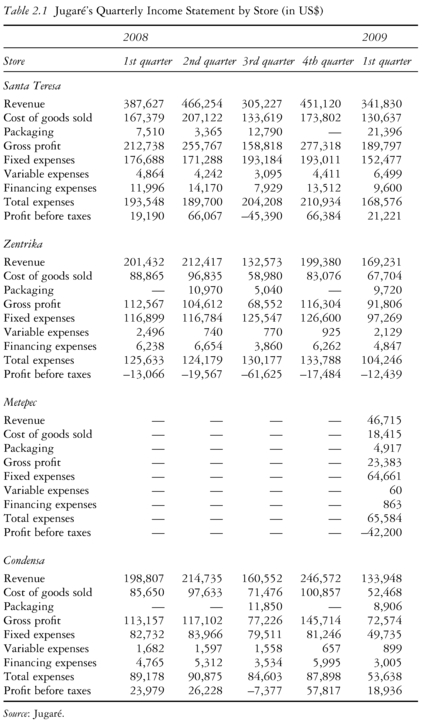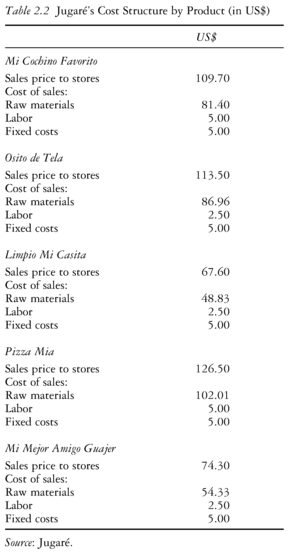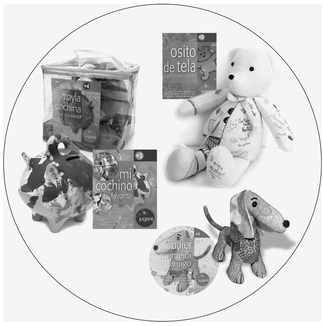2 Jugaré
Educational Toys from Mexico
Claudia González Brambila, Virginia Kalis, Humberto Valencia-Herrera, Eduardo Zelaya, and Pablo Galindo Herrera
Four friends with complementary skills launched a toy company that makes and sells educational toys. Their early success surprised them. Their greatest challenges were to find a way to become profitable and to avoid letting their venture interfere with their family lives.

Figure 2.1 Jugaré’s Logo
On a rainy summer afternoon in July 2009, Marcela Huet, Ibó Angulo, Hilda Díaz, and Laura Cortés were enjoying lattes at Café Punta del Cielo in Mexico City. The four were happy to be together again and chatting about how to expand their business in the short and long run. They had been working together for several years, but their ideas about how to expand their business differed. Laura, the production manager, thought it was time to prepare and document a business model for franchising. Ibó had been talking with the purchasing manager of a client, Casa Palacio, about selling Jugaré toys in the home furnishings store. Hilda felt it was better to start selling the toys at a museum store and had spoken with the manager at Museo Universitario de Arte Contemporáneo (MAC) at the Universidad Nacional Autónoma, who seemed interested in Jugaré products. And Marcela thought the current model was fine and, if they were able to establish an adequate fund-raising strategy, Jugaré’s growth would be guaranteed. The conversation was intense, and the four friends were a bit uncertain about the strategies needed to expand their business.
The Birth of an Idea
The four friends-turned-entrepreneurs had different skill sets and professional backgrounds. Marcela received her B.A. in communication and had spent 11 years in marketing at a record company. In 2004, she stepped out as a freelance public relations agent for several companies and then established her own agency. She has two young children and loves movies, theater, traveling, and being with her family. Laura has been her friend since 1987. Marcela met Hilda and Ibó at EMI Music in 1995 and introduced them to Laura.
Hilda received her B.A. in graphic design and began working at a design agency during her second semester. She is passionate about reading, art books, and photography. She loves painting and sports. She married in 1994 and has two daughters. Her dream is to visit the most important museums in the world.
Laura obtained her B.A. in business administration. A serial entrepreneur, she began working in the financial sector during her third semester. While in college she started Lorela, a business that rents appliances for parties and catering. In 1996 she launched Velaroma, a business dedicated to the production and sale of candles. She also earned a B.A. in professional high cuisine at the Centro Culinario Ambrosia. She is married with two daughters.
A designer at heart, Ibó has been a founding member of Zappata Diseñadores since 1994. She has received awards in the design field, including “Merit Winner” HOW Magazine (1994); Award for Publication Excellence (1997); Premio al Diseño (2001); and Premio Quorum (2002). She has also been mentioned in several publications, such as The Best of Brochure Design, 1,000 Greetings, and, more recently, Growing Graphics Design for Kids. She is passionate about design, photography, her family, her daughter, her dog, and the simple aspects of life.
On February 28, 2004, these four women were celebrating Marcela’s baby shower. Marcela had just resigned from her job, had received her severance pay, and wanted to start a new venture with her closest friends —Ibó, Hilda, and Laura. All of them were excited about the idea of becoming entrepreneurs.
The four friends met regularly to discuss what type of business they could start. They were all in their late twenties and had infants and toddlers. They realized that the available toys on the market did not encourage children’s creativity. For instance, Hilda’s daughter received twenty Barbie dolls at her birthday party. The four friends saw this as an opportunity. No one was designing toys that fostered imaginations. The friends decided to focus on interesting children in participating in daily home activities in fun and imaginative ways. In addition, Ibó’s mother had a store in the La Condesa neighborhood that had been vacant for some time. Located near downtown Mexico City, La Condesa is one of the most fashionable areas, with many high-end shops, bars, and restaurants.
Ibó and Hilda, the designers in the group, developed several prototypes for the first kits. Laura, the business administrator, initiated a production plan to manufacture the toys. Marcela, the marketing specialist, was in charge of remodeling the store.
The adventure began, with an initial investment of US$20,000 ($5,000 from each entrepreneur). The friends’ living rooms became the workshops for manufacturing a dozen of each of the twelve different kits. By December 8, 2005, the first Jugaré store opened its doors as a new “Place to grow playing.”
The friends thought of Jugaré as “a fresh and innovative learning concept, 100 percent Mexican, concerned with children’s development, imagination, and creativity through play, encouraging in this way a bond between parents and kids,” according to an early marketing brochure. “We believe toys are a great source of learning for our children, and what a nice way to learn!” The company’s slogan was “Toys that foster intelligent play.”
The Toy Industry in Mexico
Children aged 12 and younger are the primary consumers in the toy and game market, estimated to be 30 million people in Mexico. Although this country has a shrinking population in this segment, the growing pur chasing power of working adults is expected to increase demand a bit in the coming years.
Large firms offer a wide variety of toys and have economy-of-scale advantages in purchasing, manufacturing, distributing, selling, and marketing. This explains why the toy and game market in Mexico is dominated by large firms such as Mattel and Hasbro. The small firms are able to compete by specializing in specific product markets, such as educational or traditional toys.
Toy manufacturers face increasing competition from electronic entertainment for children, including the Internet, video games, television, and other consumer electronics. In Mexico, about 75 percent of videogames offered at very cheap prices are thought to be counterfeit or pirated.
The toy and game industry in Mexico is highly seasonal, with the strongest sales occurring during the Christmas season—including Three Wise Men’s Day (January 6)—and for Children’s Day (April 30).
Toys sold in Mexico are manufactured primarily by large multinational firms such as Mattel and Hasbro. The industry is highly concentrated, with the main manufacturers amassing most of the sales. These two large firms support sales efforts through publicity and advertising, and both have strong infrastructures devoted to new product innovation and development.
A major concern for Mexican toy manufacturers is the toys imported illegally from East Asian countries, mainly China. In Mexico, Chinese toy manufacturers face stiff tariffs, some up to 1,000 percent. There is also an illegal market in counterfeit toys, offered primarily through the informal sector. It is possible that these tariffs will be reduced in the future, given that China has been a member of the World Trade Organization since 2001.
The strong competition from the main international and East Asian toy manufacturers has forced Mexican toy firms to concentrate on niche markets. The 2004 Economic Mexican Census registered 281 toy distributors in Mexico, employing on average fourteen persons, with annual sales of US$15.3 million each and assets of US$0.5 million.1 In the educational market, the strongest manufacturing and distribution firm is Algara, which offers children many science-oriented toys and games, such as chemistry games, marine biology activities, and microscopes. Many of the local manufacturers have outdated manufacturing plants, which puts them at a disadvantage when they compete with Chinese manufacturers.
Other educational toy firms offering products in Mexico include Alex Toys, Juguetes Nip, and Imaginarium. Alex Toys is a well-known manufacturer in the U.S. and sells its products in Mexican department stores and at the Gandhi bookstores in Mexico City. Juguetes Nip specializes in painting and decorative toys imported from the U.S., with three stores in Mexico City. Imaginarium, with eleven stores at large shopping malls in major Mexican cities, distributes toys and children’s furniture. Its prices are 35–45 percent higher than Jugaré’s, and it has strong brand recognition.
The traditional toys-and-games market is a niche dominated by small family firms. Because they often lack distribution channels, they can offer their toys only in their local communities. Some of these toys are distributed through public and movable street markets on wheels (mercados sobre ruedas)2 in the main urban areas. These products usually lack attractive packaging, but they are offered at relatively cheap prices and are sold tax-free.
This market has shown strong growth in recent years. It increased by nearly 15 percent in 2007 and by 18 percent in 2008, reaching US$23 billion in sales.3 The 2009 slowdown in growth resulted mainly from the country’s economic downturn, driven by increased oil prices and decreasing remittances from the U.S. due to the financial crisis.
Most retail toy sales take place at supermarkets, such as Walmart (more than 700 stores), Soriana (160 hypermarts and 260 stores), and Comercial Mexicana (27 hypermarts, 175 stores), which are the main chain stores in Mexico. In addition, there are specialized toy stores, which are primarily micro-firms with one or two employees (54 percent of the sales). Many of them operate in public and/or movable street markets. Other retail channels include department stores, gift shops, and drugstores. These main retail firms are using “just-in-time” processes to a greater extent, forcing local producers to bear the burden of inventories and accounts receivable.
Many toy and game companies outsource toy parts to multiple third-party manufacturers and then assemble and package the final products. Most companies produce toys through third-party contract manufacturers in the Far East, primarily China, due to its low production and labor costs. However, some companies prefer to use Mexican manufacturing locations to avoid the lengthy transportation time. To minimize this problem, most companies in the Far East must produce toys well in advance of when customers take delivery; and some large retailers place positional orders over a year in advance for toys manufactured abroad. Given that actual sales may often vary from projections, there are frequent inventory excesses and shortages. In Mexico, the major raw materials used to manufacture toys and games are rubber (31 percent of the total cost), plastic (24 percent), paper (18 percent), and cloth (18 percent).4
The First Steps
The entrepreneurs expected to sell US$1,200 in merchandise in the first month—December 2005. By the end of the first week, they had sold US$800 of their inventory, and the store looked almost empty. Customers bought everything in sight, and the owners were already worried about not being able to meet market demand—a nice problem to have. Table 2.1 shows the quarterly income of each store (for all of 2008 and the first quarter of 2009).
That month was one of the most hectic Decembers at Jugaré. The four friends needed to produce more toys faster. In addition, because it was Christmas time, their houses could not look like factories because of the season’s family events. Thus, they moved production to a little room located next to the store. This room was outfitted with two tables, and the four friends assembled the toys themselves as fast as they could. By January they were exhausted, so they decided to hire one woman to be in charge of store sales and two other women to be production assistants.
The overwhelming market acceptance of the Jugaré products was very exciting and gave the friends the confidence to start expanding their catalogue, offering up to eighty different toy kits by the end of their first 18 months of operation. Jugaré products are designed for well-do-do children between ages 3 and 12 whose mothers are concerned about the overuse of electronic games and are seeking alternatives for play and learning. Moreover, because the friends’ own toys were not suitable for children under 3, they introduced new products from other brands for this particular group. (About 80 percent of the displayed products in the Jugaré stores are the company’s own products, and the rest are made up of other brands.)
The idea that was born at Marcela’s baby shower turned out to be so successful that investors were now interested in franchising the business model. The four founders knew that Jugaré needed to expand. However, they wanted to keep the brand for themselves, as well as the toy production.
On the other hand, they did not have money to open a new store on their own. So they decided to create three different legal entities: one for the workshop, a second for the La Condesa store and the registered brand of Jugaré, and a third to handle opening new stores with new capital investors.
The Design and Production Process
The four friends knew that product innovation was Jugaré’s core competitive advantage. Thus, all of them participated in the brainstorming process (phase 1). They constantly looked at daily activities from a child’s point of view to identify interests that could be turned into educational adventures. The golden rule for enhancing creativity among the team had always been that all ideas could and should be discussed. Once the group had a good idea, Hilda and Ibó, the two designers, developed a prototype (phase 2). Then they would all get a steady stream of feedback, not only from adults, but especially from children. During phase 3, each prototype was evaluated and refined. Then implementation began.
At this point, Laura, the production manager, made a list of the raw materials needed to produce each new kit. Then the four friends searched for the best supplier in terms of quality and cost. This process could be problematic. Sometimes the best supplier, in terms of quality, was unable to produce the required quantity. Other times, the supplier charged a high unit price because the order was not large enough to be considered wholesale. Table 2.2 details the company’s cost structure for different kinds of products (see also Figure 2.2).
Laura programmed an Excel macro spreadsheet that linked the name of each kit with the quantity and unit price of the raw materials needed to produce it. This way, all the owners knew the cost of each kit. The first production batch was 100 kits. Assembly was undertaken on large tables and organized in a production line.
The decorative box is a crucial aspect of Jugaré’s products. Each box is designed creatively with many colorful details. The founders are convinced that the best publicity for their brand is their showy boxes on the gift tables at birthday parties. Each kit is packaged carefully and then distributed to the stores. The flashy boxes have been so successful that, in a recent international competition on design for kids (“Growing Graphics”), Jugaré was selected as one of the finalists and is to be featured in the publication.
The stores send a weekly sales report to Marcela, who is in charge of the sales projections. She then sends the requirements to Laura, who schedules the production of kits. Each production batch is a minimum of 100 kits.
Given that most of the kits have up to fifty different raw materials, a more efficient system of inventory management became imperative—not
only for physical inventory but also for a system that allows for enterprise resource planning (ERP). The main obstacle for this purchase is the lack of capital. Another limitation is that, despite the company’s enormous growth, it is still small, so all purchases are handled in cash and only one supplier gives them credit.
The partners’ own skills have not been sufficient to manage the growth of production. Marshaling their talents and energies, they decided to hire a consultant to help them organize the production, inventory management, material purchases, manufacturing, logistics, and so on.
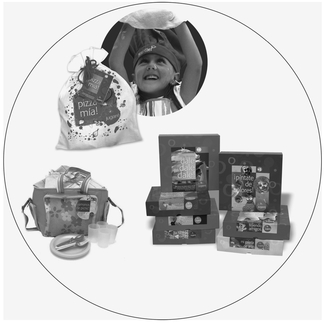
Figure 2.2 Various Jugaré Products
Source: Jugaré.
Devising a Strategy for Growth
This is the decision breakpoint for Jugaré. As a result of their initial success, the entrepreneurs must determine the best growth strategy for the future of their company. One option they are considering is franchising. Some of the pros they must consider are whether this could represent a fast expansion all over the country, without any additional equity, and whether any risk associated with the growth would be shared with the franchisees. Among the cons are that the friends have not yet assembled all the documentation they need to franchise—e.g., business plans, training schedules, operation manuals, and management procedures to maintain the same quality of the current stores.
Another option they are considering is selling the merchandise at different retail stores. The products could be commercialized at specialty stores such as Casa Palacio, MUAC, Gandhi bookstores, and Museo del Niño, among others. The products could also be sold directly to wholesale vendors such as Walmart and Comercial Mexicana. Marcela posits that this would be good because many of the kits could be sold in a short period of time, the market share would rise rapidly, and a larger group of customers would become aware of the Jugaré brand. Laura, however, feels the main disadvantage is that, at the moment, the workshop lacks sufficient production capacity to satisfy the great demand these stores would require. She is also concerned about the production and distribution costs associated with a significant expansion.
The entrepreneurs are also considering the importance of forming strategic alliances with outside clients—e.g., Piccolo Mondo, Gymboree, private or public elementary schools, or children’s entertainment companies. Whatever strategy they choose, they will also have to take into account the advertising and marketing strategies, the control and production planning, and the management and control costs.
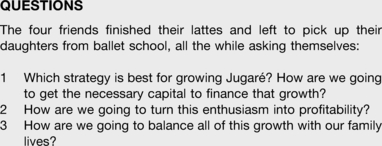
Notes
1 INEGI (2006), Industria Manufacturera, Censos Económicos 2004, Aguascalientes, Mexico: Instituto Nacional de Geografía, Estadística e Informática, ISBN: 970–13–4700–5, p. 42.
2 The mercados sobre ruedas are street merchants who change their location daily. They have small shops, each one specializing in different products—e.g., fruits, vegetables, clothes, small appliances, and toys.
3 Euromonitor International Inc. (2009), Toys and Games in México, Country Report, London, http://www.euromonitor.com/Toys_And_Games, consulted on August 8, 2009.
4 INEGI (2006), Industria Manufacturera, Censos Económicos 2004, Aguascalientes, Mexico: Instituto Nacional de Geografía, Estadística e Informática, ISBN: 970–13–4700–5, table 4.

